The Owl Nebula, Messier 97 (M97), is a famous planetary nebula located at an approximate distance of 2,030 light-years in the northern constellation Ursa Major (the Great Bear). With an apparent magnitude of 9.9 and an apparent size of 3.4 by 3.3, it is one of the brightest planetary nebulae in the sky. It has the designation NGC 3587 in the New General Catalogue.
The Owl Nebula is known for its distinctive appearance, with two dark patches that resemble the eyes of an owl. The nebula is visible in binoculars in good conditions, but the pair of owl-like eyes can only be seen in medium and larger telescopes in very clear, dark skies.
The Owl Nebula has an estimated age of 8,000 years. It is expanding at 27 – 39 km/s. It formed when its central evolved star reached the end of its life cycle and expelled its outer gaseous layers into space. As the outer layers were gradually blown off through a stellar wind over thousands of years, what was left of the progenitor star started to contract and it will eventually become a hot white dwarf. The intense ultraviolet radiation from the central star ionizes the expelled material, making it produce its own light and glow as a planetary nebula.
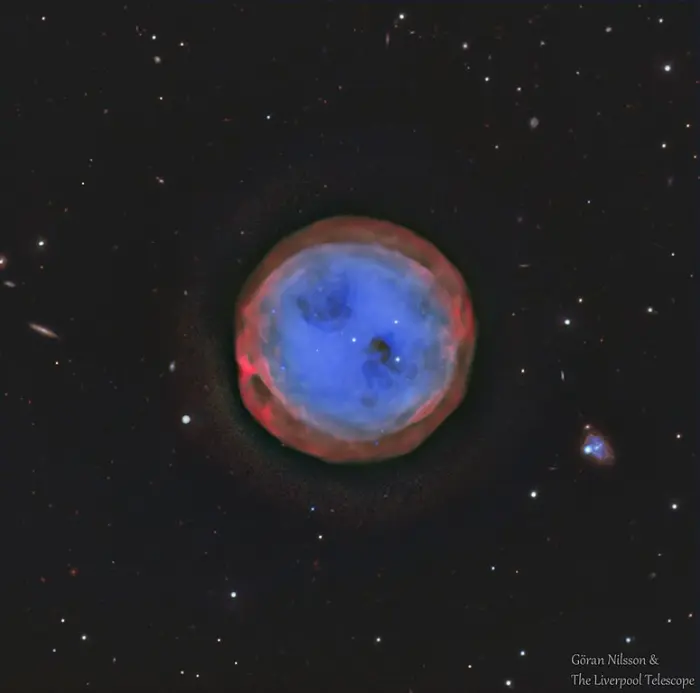
HaRGB image of the Owl Nebula M97. Data from the Liverpool Telescope, a 2 m RC telescope on La Palma, processed by Göran Nilsson. Credit: Göran Nilsson & The Liverpool Telescope (CC BY-SA 4.0)
Most sources place Messier 97 at a distance of 2,030 light-years from the Sun. However, more recent studies suggest that the cosmic Owl may be much further away. In 2015, an international team of astronomers found a “gravity distance” of 0.87 ± 0.26 kiloparsecs (2,800 light-years) for the nebula, based on the nebular Hα flux.
The central star of the Owl Nebula is a 14th magnitude star with a mass 55 – 60% that of the Sun and an effective temperature of 123,000 K. It is between 41 and 148 times more luminous than the Sun. Spectroscopic measurements give an effective temperature of 94,000 K and a luminosity of around 140 Suns. The star was resolved with the infrared Spitzer Space Telescope in 2012. It does not exhibit an infrared excess, which would suggest the presence of a circumstellar disk.
The nebula has a radius of 0.91 light-years and contains around 0.13 solar masses of material. It is composed of elements that include hydrogen, helium, nitrogen, oxygen, and sulfur.
The Owl Nebula is roughly circular and contains three concentric shells. These shells outline the nebula’s history, indicating three separate phases of large-scale mass ejection. The bright inner region of the nebula has a double-shell structure, with apparent diameters of 15 and 38 arcminutes.
The inner shell is not symmetrical. It has a barrel-like structure that is tilted at an angle of 45 degrees to our line of sight. The outer shell is around 20 – 30 percent larger than the innermost shell.
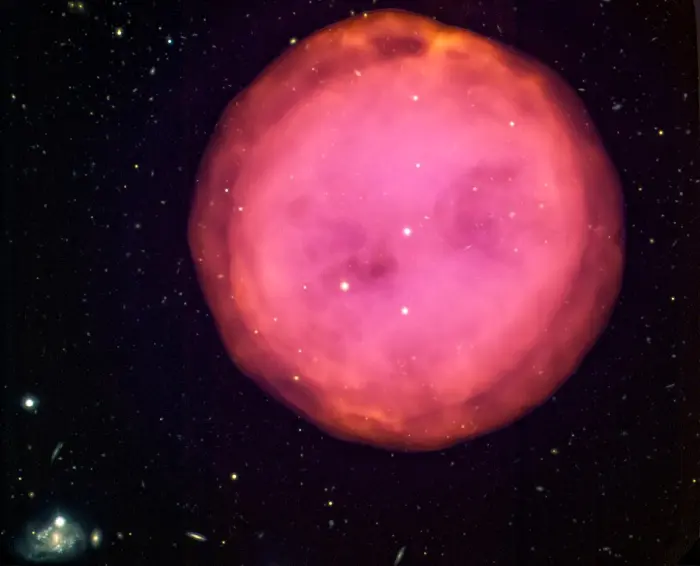
Gemini North image of the planetary nebula M97, also known as the Owl Nebula, imaged by the Gemini Multi-Object Spectrograph (GMOS) as part of a Canadian contest for high school students. Image credit: International Gemini Observatory/NOIRLab/NSF/AURA/Émilie Storer (Collège Charlemagne, QUE)/André-Nicolas Chené (HIA/NRCof Canada)/T. Rector (U.Alaska, Anchorage) (CC BY 4.0)
The giant halo that surrounds the celestial Owl is very large, with an apparent size of 18 by 24 arcminutes, and very faint. It was first spotted by Minkowski in the 1960s. However, it was not associated with M97 until the early 1980s, when Howard E. Bond of the Department of Physics and Astronomy, Louisiana State University, discovered it on prints of the Palomar Sky Survey. Bond estimated that the central star expelled the material that produced the halo approximately 100,000 years ago.
The Owl’s eyes were long believed to be a bipolar cavity within the nebula’s inner shell. The cavity was carved out by a strong stellar wind which has since ceased. More recent observations and modelling suggest a tripolar model.
In 2018, a team of astronomers led by M. T. García-Díaz of the Institute of Astronomy, National Autonomous University of Mexico, developed a 3-D morpho-kinematic model of M97 and found that the nebula’s inner cavity consisted of a tripolar structure that contained multi-polar “fingers” instead of having a bipolar dumbbell shape.
The astronomers proposed that the Owl Nebula and three similar nebulae constitute a new class of planetary nebulae called strigiform nebulae (owl-like nebulae). These nebulae are characterized by a double shell structure, central stars with low luminosity and high gravity, asymmetric inner cavities without bright rims, and no evidence of a present-day stellar wind.
The Owl Nebula will gradually disperse over the next several thousand years. The central white dwarf will cool and fade away. In about 5 billion years, our Sun will end its life in similar fashion.
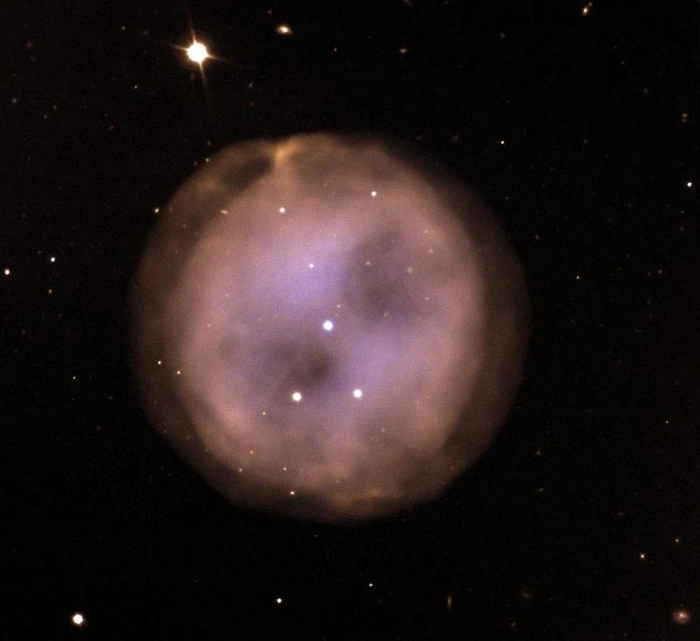
Owl Nebula (M97), image credit: ESO/Digitized Sky Survey 2 (CC BY 4.0)
Facts
The Owl Nebula was discovered by the French astronomer Pierre Méchain on February 16, 1781. Méchain reported that the nebula was a difficult object to see. Three days later, he discovered the edge-on spiral galaxy Messier 108 in the same area of the sky.
Méchain’s friend and colleague Charles Messier included the nebula in his catalogue on March 24, 1781.
Messier noted, “Nebula in the great Bear, near Beta: It is difficult to see, reports M. Méchain, especially when one illuminates the micrometer wires: its light is faint, without a star. M. Méchain saw it the first time on Feb 16, 1781, & the position is that given by him. Near this nebula he has seen another one [M108], which has not yet been determined, and also a third [M109] which is near Gamma of the Great Bear.”
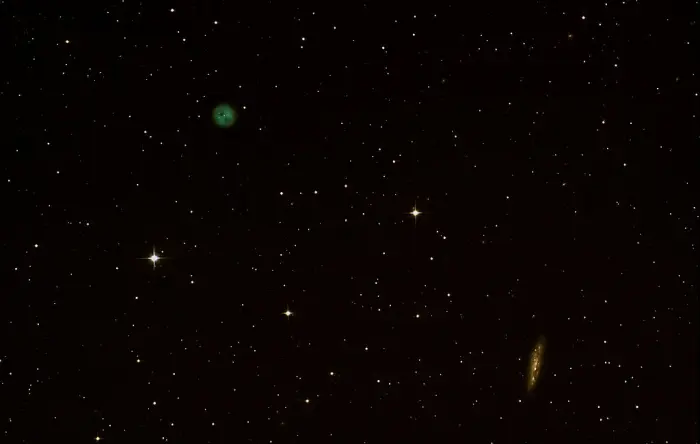
Messier 97 and Messier 108, image: Miodrag Sekulic (CC BY-SA 3.0)
The two “nebulae” Messier mentioned in his description of M97 were later named Messier 108 and Messier 109 by the American astronomer Owen Gingerich and added to Messier’s catalogue in 1960. They are in fact barred spiral galaxies.
There are several remote galaxies lying in the same line of sight as the Owl Nebula. The galaxies have the designations PGC 34279, PGC 2490640, and PGC 2490291.
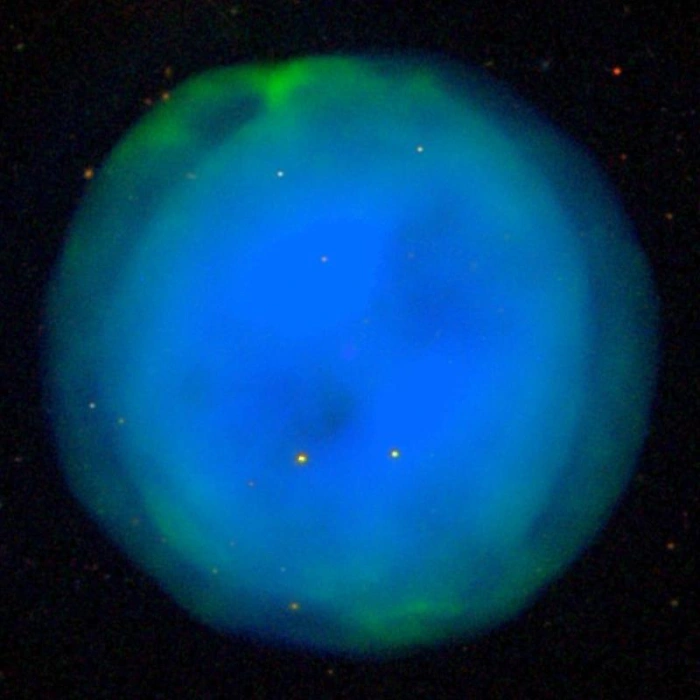
Owl Nebula, image: Sloan Digital Sky Survey (CC BY 4.0)
M97 is considerably brighter visually than photographically because most of its light is emitted in one green spectral line.
M97 is one of only four planetary nebulae listed in Messier’s catalogue, along with the Dumbbell Nebula (Messier 27) in the constellation Vulpecula, the Ring Nebula (Messier 57) in Lyra, and the Little Dumbbell Nebula (Messier 76) in Perseus. These are some of the brightest planetary nebulae in the sky, along with the Helix Nebula (NGC 7293) and Saturn Nebula (NGC 7009) in Aquarius, the Butterfly Nebula (NGC 6302) in Scorpius, and the Blue Planetary Nebula (NGC 3918) in Centaurus.
The Owl Nebula is one of seven Messier objects in Ursa Major, along with the double star Messier 40 (Winnecke 4), Bode’s Galaxy (Messier 81), the Cigar Galaxy (Messier 82), the Pinwheel Galaxy (Messier 101), the Surfboard Galaxy (Messier 108), and the spiral galaxy Messier 109.
The Owl Nebula is one of the faintest Messier objects. It is quite large and has a relatively low surface brightness, but it can be seen in amateur telescopes with an O-III filter in good conditions, with clear skies and no light pollution. The nebula can even be spotted with larger binoculars. However, to see why it was named the Owl, one needs a larger instrument, starting from a 10-inch telescope at moderately high power. The 14th magnitude central star can be seen in 10-inch or larger telescopes.
Admiral William H. Smyth, a 19th century English astronomer and hydrographer, was the first to classify Messier 97 as a planetary nebula in 1844. He described it as a “large planetary nebula, or globular collection of nebulous matter,” adding, “This very singular object is circular and uniform, and after a long inspection looks like a condensed mass of attenuated light, seemingly of the size of Jupiter.”
M97 became known as the Owl Nebula after the English astronomer and engineer William Parsons, 3rd Earl of Rosse, drew an illustration of the object in 1848. Lord Rosse observed the nebula with his home-made 72-inch reflector, known as the Leviathan of Parsonstown, in Ireland. His sketch of the nebula resembled an owl’s head. Lord Rosse described the object as “Two stars considerably apart in the central region, dark penumbra round each spiral arrangement, with stars as apparent centres of attraction. Stars sparkling in it; resolvable.”
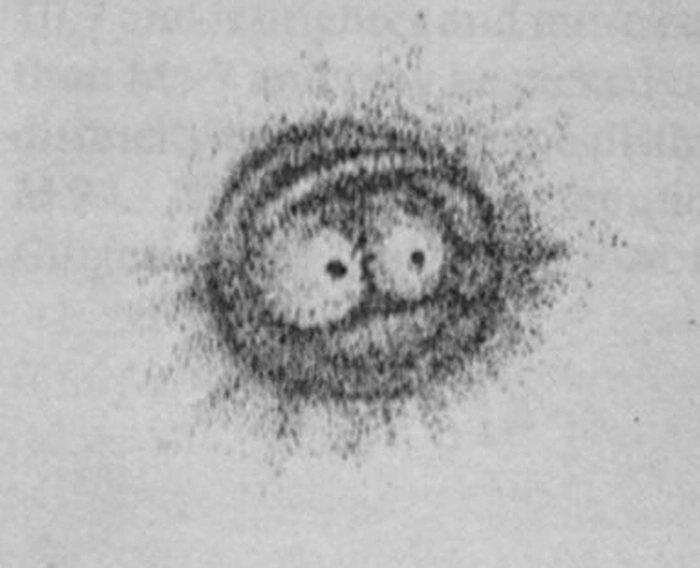
Drawing of the Owl Nebula (M97) by Lord Rosse, Philosophical Transactions of the Royal Society of London, Vol. 140 (1850)
The Owl Nebula has a southern counterpart located in the constellation Hydra. The Southern Owl Nebula (PLN 283+25.1, ESO 378-1) is a strikingly similar planetary nebula to the northern Owl and lies at the same distance, 2,030 light-years away. However, the Southern Owl is much fainter than M97. With an apparent visual magnitude of 17.4, it is only visible in large instruments.
The Owl Nebula is one of several bright northern deep sky objects that have their counterparts in the southern hemisphere. Others include the Ring Nebula (Messier 57) in Lyra and the Southern Ring Nebula (Caldwell 74, NGC 3132) in Vela, the Pleiades (Messier 45) in Taurus and the Southern Pleiades (Caldwell 102, IC 2602) in Carina, the Crab Nebula (Messier 1) in Taurus and the Southern Crab Nebula (Hen 2-104) in Centaurus, and the Pinwheel Galaxy (Messier 101) in Ursa Major and the Southern Pinwheel Galaxy (Messier 83) in Hydra.
Location
The Owl Nebula is easy to find because it lies in the region of the Big Dipper, the most recognizable asterism in the northern celestial hemisphere. It appears about 2.5 degrees east-southeast of Merak (Beta Ursae Majoris), just south of the imaginary line connecting Merak and Phecda (Gamma Ursae Majoris). Merak and Phecda are the stars that form the base of the Big Dipper’s bowl. Merak and the brighter Dubhe are known as the Pointer Stars. They point in the direction of Polaris (the North Star) and the northern celestial pole.
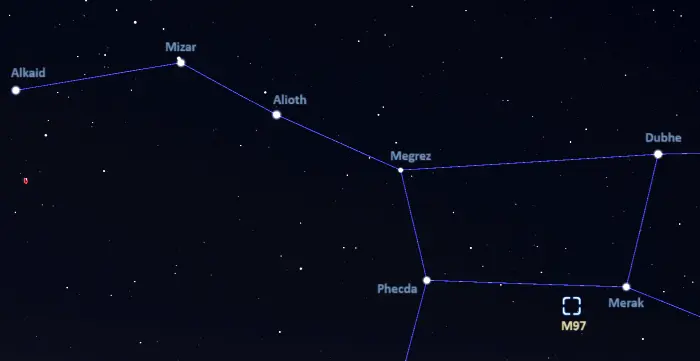
The location of the Owl Nebula (Messier 97), image: Stellarium
The barred spiral galaxy Messier 108 appears near the Owl Nebula. The galaxy can be seen at about a third of the distance between M97 and Merak. The two relatively bright objects are a popular target for astrophotographers because they fit in the same wide field of view.
At declination +55°, Messier 97 never rises for observers south of the latitude 35° S and is best seen from the northern hemisphere. It never appears very high above the horizon for observers in the southern hemisphere.
The best time of the year to observe the Owl Nebula and other deep sky objects in Ursa Major is during the month of April, when the Great Bear appears higher above the horizon in the early evening.
Owl Nebula – Messier 97
| Constellation | Ursa Major |
| Object type | Planetary nebula |
| Right ascension | 11h 14m 47.7122947800s |
| Declination | +55° 01′ 08.482832076″ |
| Apparent magnitude | 9.9 |
| Apparent size | 3′.4 × 3′.3 |
| Distance | 2,030 light years (621 parsecs); 2,800 ly (870 pc) |
| Radius | 0.91 light-years (0.28 parsecs) |
| Mass | 0.13 M☉ |
| Names and designations | Owl Nebula, Messier 97, M97, NGC 3587, PN G148.4+57.0, PN VV 59, PN VV’ 107, PN ARO 25, PK 148+57 1, AG82 135, BWE 1111+5517, CSI+55-11119, EUVE J1114+55.0, 2EUVE J1114+55.0, GCRV 6897, GB6 B1111+5517, RX J111447.9+550106, 87GB 111154.0+551728, LJHY 9, GALEX J111447.9+550112, GALEX J111447.8+550111, GALEX J111447.9+550110, TIC 309863161, NVSS J111443+550045, NVSS J111450+550126, PSCz P11119+5517, WD 1111+552, SDSS J111447.70+550108.7, SDSS J111447.71+550108.4, IRAS 11119+5517, IRAS F11118+5517, 2MASS J11144772+5501085, WN B1111.8+5517A, WN B1111.8+5517B, Gaia DR2 843950873117830528, Gaia DR3 843950873117830528 |
Images
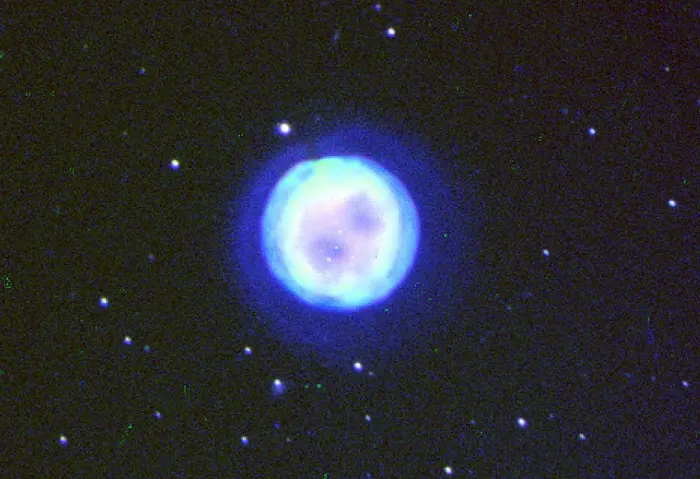
This composite image of the Owl Nebula (also known as M97 or NGC3587) was created from three sets of narrowband images taken at the 0.6-meter Burrell Schmidt telescope at Kitt Peak National Observatory in June 1991. The colors in the image correspond to oxygen [O III] in blue, nitrogen [N II] in green, and hydrogen [H-alpha] in red.This image was the subject of NOAO Press Release 03-06. Image credit: Karen Kwitter (Williams College), Ron Downes (STScI), You-Hua Chu (University of Illinois) and NOIRLab/NSF/AURA (CC BY 4.0)
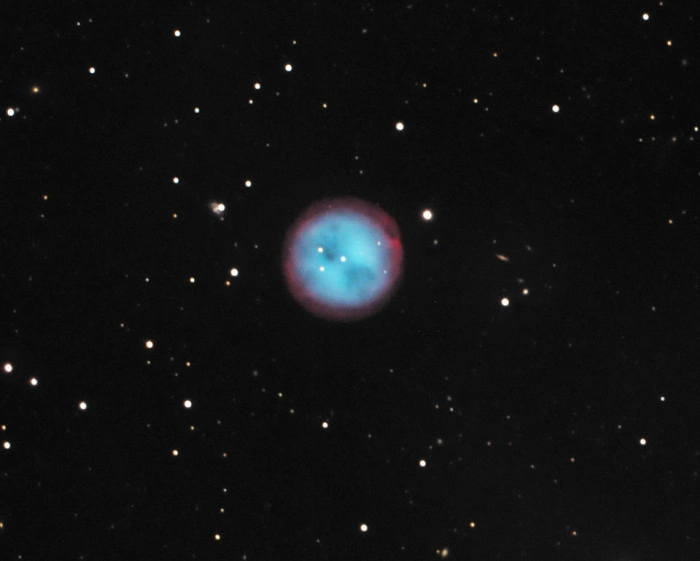
Owl Nebula, credit: Stargazer Observatory (PD)
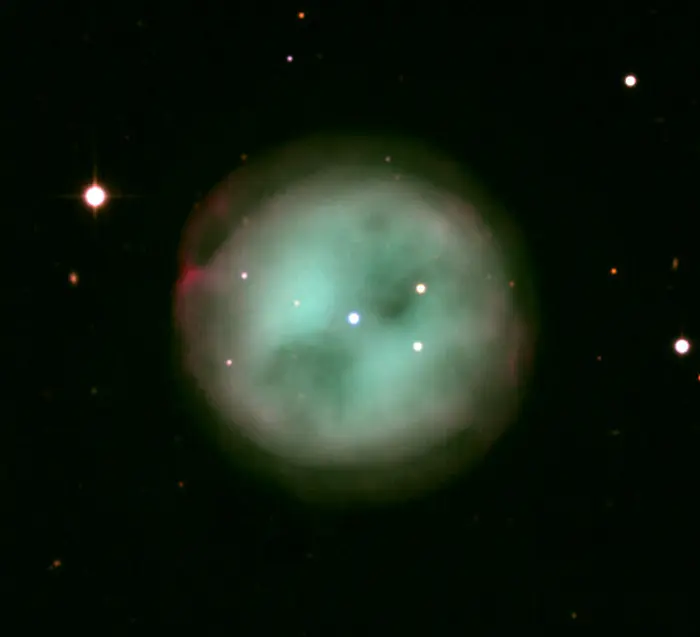
The Owl Nebula, M97, is one of the more complex planetary nebulae. Appearing in the constellation Ursa Major, it is also one of the fainter Messier objects. This picture is from the KPNO 0.9-meter telescope. Credit: NOIRLab/NSF/AURA (CC BY 4.0)
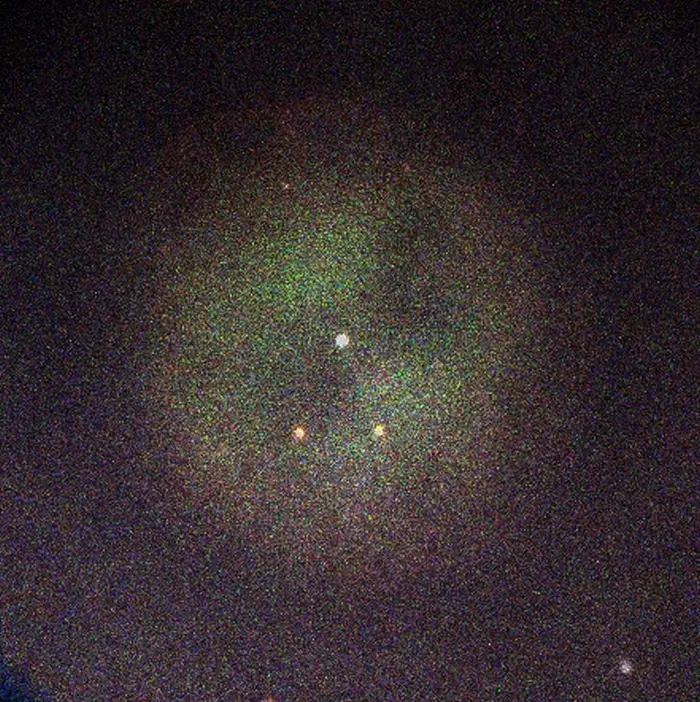
Messier 97, image credit: Jessica Barton, Faulkes Telescope North (CC BY-SA 3.0)